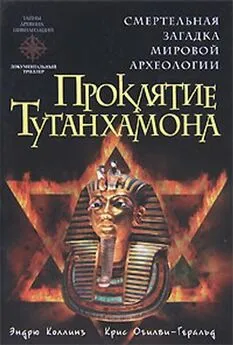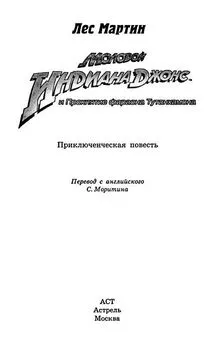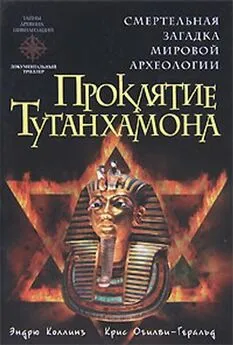Крис Огилви-Геральд - Проклятие Тутанхамона
- Название:Проклятие Тутанхамона
- Автор:
- Жанр:
- Издательство:М.: Эксмо, 2010. — 544 с.: ил
- Год:2010
- ISBN:978-5-699-41545-8
- Рейтинг:
- Избранное:Добавить в избранное
-
Отзывы:
-
Ваша оценка:
Крис Огилви-Геральд - Проклятие Тутанхамона краткое содержание
День 4 ноября 1922 года стал одним из величайших в истории мировой археологии. Именно тогда знаменитый египтолог Говард Картер и лорд Карнарвон, финансировавший раскопки, обнаружили гробницу фараона Тутанхамона, наполненную бесценными сокровищами Однако для членов экспедиции этот день стал началом кошмара. Люди, когда-либо спускавшиеся в усыпальницу, погибали один за другим. Газеты принялись публиковать невероятные материалы о древнем египетском демоне, мстящем археологам за осквернение гробницы…
В своей увлекательной книге известные исследователи исторических аномалий Коллинз и Огилви-Геральд подробно изложили хронологию открытия гробницы Тутанхамона и связанных с этим загадочных событий Основываясь на письмах и статьях знаменитых археологов, а также воспоминаниях очевидцев, авторы задаются сенсационным вопросом: не могли ли Говард Картер и лорд Карнарвон обнаружить в гробнице Тутанхамона некую взрывоопасную тайну, способную в случае огласки перевернуть сложившиеся взгляды на библейскую и мировую историю? И не могла ли эта тайна стать для первооткрывателей усыпальницы реальным проклятием — осуществляемым не мстительными богами Египта, а наемными убийцами на службе влиятельных политических сил, которым могла помешать неудобная правда?..
Andrew Collins, Chris Ogilvie-HeraldTUTANKHAMUN. THE EXODUS CONSPIRACY;TRUTH BEHIND ARCHAEOLOGY» S GREATEST MYSTERY
Перевод с английского кандидата филологических наук С.В.Головой и А.М.ГоловаОформление обложки художника Евгения Савченко
Проклятие Тутанхамона - читать онлайн бесплатно полную версию (весь текст целиком)
Интервал:
Закладка:
30Ibid., fr. 50, from Josephus, Contra Apionem; fr. 51, from Theophilus, Ad Autolyc. iii. 19.
31Ibid., fr. 50, from Josephus Contra Apionem; fr. 51, from Theophilus, Ad Autolyc. iii. 19.
32Ibid., fr. 52, from Syncellus, according to Africanus.
33Ibid., fr. 53 (a), from Syncellus, according to Eusebius; fr. 53 (b), Armenian version of Eusebius.
34Ibid., fr. 50,1. 96, from Josephus, Contra Apionem, who gives the reign of Ramessesas 1 year 4 months; fr. 51, from Theophilus, Ad Autolyc, iii. 19, who gives him 1 year 4 months; fr. 52, from Syncellus, according to Africanus, who gives him 1 year; fr. 53 (a), from Syncellus, according to Eusebius, who gives him 68 years; 53 (b), Armenian version of Eusebius, which gives him 68 years.
35Ibid., fr. 50, 1. 96, from Josephus, Contra Apionem, who gives the reign of Harmals as 4 years 1 month; fr. 51, from Theophilus, Ad Autolyc, iii. 19, who gives the reign of Harmais as 4 years 1 month; fr. 52, from Syncellus, according to Africanus, who gives the reign of Armesis as 5 years; fr. 53 (a), from Syncellus, according to Eusebius, who gives the reign of «Armais, also called Danaus» as 5 years; 53 (b), Armenian version of Eusebius, which gives the reign of Armais, also called Danaus» as 5 years.
36Ibid., fr. 53 (a), from Syncellus, according to Eusebius.
37Ibid., fr. 53 (b), Armenian version of Eusebius.
38Ibid., fr. 53 (a), Syncellus's additional note to Eusebius's text.
39See Manetho, trans. Waddell, fr. 52, from Africanus.
40For a full resume of these different Graeco-Egyptian and Graeco-Roman Exodus accounts, see Redford, 1986, pp. 282—96.
41See, for instance, Lysimachos, Aegyptiaca, from Josephus, Contra Apionem, trans. Waddell, I, 34.
42Ibid.
43Ibid.
44Ibid., I, 35.
45Cheremon, quoted in ibid., I, 33.
46Ibid.
47Pompeius Trogus, quoted in Assmann, p. 36.
48Bower, Scotichronicon, I, 9.
49Ibid.
50Ibid., I, 12.
51Ibid., I, 14.
52Ibid., I, 15.
53Ibid., I, 18.
54Ibid.
55For the descendants of Scota colonising the Irish DilRiata, see Lebor Gabala Erenn: The book of the taking of Ireland, Bk. 5, VIII, 384-6. Bk. 5, VIII, 387.
56For Scota going to Scotland see the «Pleading of Baldred Biset», 1301, as referenced in the Intro, to Bower, p. xx.
57For Scota going straight to Ireland see «Instructions», 1301, as referenced in the Intro, to Bower, p. xx.
58For Scota going first to Ireland and then on to Scotland see Chron. Piets-Scots, 106— 16 and SEHI, 609—10, as referenced in the Intro, to Bower, p. xix. Here Scota is the wife of Neius or Niulus, a Greek, the son of a certain Lacedaemonian Aeneas, a prince of the Choriscii.
59See the «Pleading of Baldred Biset», f 301, as referenced in the Intro, to Bower, p. xx.
60Nennius, Historia Brittonum, 15.
61Bower, I, 10.
62See Evans, Kingdom of the Ark.
63Moran, The Amama Letters, EA35, 11–15.
64Aldred, p. 283.
65Ibid.
66Goetze, «The Plague Prayers of Mursilis» in Pritchard (ed.), Ancient Near Eastern Textsre lating to the Old Testament, KUB, xiv, 8; KUB, xxiv, 3, pp. 394—6.
67Ibid. KUB, xiv, 8, p. 394.
68Ibid., KUB, xiv, 8, p. 395.
69Ibid., KUB, xxiv, 3, p. 396.
70Kitchen, Suppiluliuma and the Amama Pharaohs: A Study in Relative Chronology, p. 47.
71Moran, EA11, 5—14.
72Phillips, Act of God, pp. 301—2.
73Ex. 11: 1.
74Ex. 12: 29–30.
75Phillips, pp. 302—3.
76Gardiner, Egypt of the Pharaohs, pp. 244—5.
77Redford, 1986, p. 282.
ГЛАВА ВОСЕМНАДЦАТАЯ. В ПОИСКАХ ЯХВЕ
1Giveon, «Toponymes quest-Asiatiques a Soleb», in VT 14,1964, pp. 239—55; Giveon, Les Bedouins Shosou des documents Egyptians, 1971, pp. 24—8.
2Giveon, 1964, pp. 244—5; Giveon, 1971, pp. 25—7.
3Giveon, 1964, pp. 244—5; Giveon, 1971, p. 27.
4Redford, Egypt, Canaan, and Israel in Ancient Times, p. 272 n. 70, cf. P. Harris I, 76:9 («Se» ir with the Shasu clans»).
5Ward, «The Shasu «Bedouin»: notes on a recent publication», JESHO 15 (1972), pp. 50-1.
6Ibid.
7Grdseloff, «Edom, d'apres les sources egyptiennes», RHJE 1 (1947), p. 74 n. 1, after Champillion and Sethe.
8P Anastasi IV, 18, quoted in Redford, p. 228.
9Bedford, p. 203.
10Redford, p. 270. See also Moran, The Amama Letters, EA 285: 5–6.
11Barkay, «What's an Egyptian Temple doing in Jerusalem?», BAR 26:3 (May/June 2000), pp. 48–57, 67.
12Redford, p. 271. See also Moran, EA 287.
13Redford, p. 275; Ward, p. 46
14Redford, p. 275.
15Giveon, 1971, pp. 235—6.
16Ward, p. 52, cf. P Anastasi I, 19, 1–4 & 23, 7–8.
17Ibid., p. 53.
18Ibid., p. 54.
19Giveon, The Shasu of the Late XXth Dynasty», JARCE 8 (1969-70), p. 52.
20Giveon, 1971, pp. 48—9-
21Giveon, 1969—70, pp. 51—3.
22Giveon, 1971, p. 28.
23Ibid., p. 28.
24Ibid., p. 236.
25See Grdseloff, pp. 86, 98—9.
26Ibid., pp. 81-2.
27Redford, pp. 272-3.
28Giveon, 1971, pp. 74—7; Grdseloff, pp. 79–83.
29Gen. 32: 38.
30See Greenberg, The Hab/piru, and Na'aman, «Habiru and Hebrews: the transfer of a social term to the literary sphere», JNES 45: 4 (1986), pp. 271—88; Rowton, «Dimorphic structure and the problem of the «Apiru-'Ibrtm», JNE§ 35:1 (1976), pp. 13–20.
31Ех. 3: 1.
32Easton, The Illustrated Bible Dictionary, s.v. «Horeb», p. 336.
33Ex. 3: 14.
34Ex. 3: 15, trans. Propp. Exodus 1—18: A New Translation with Introduction and Commentary, p. 6.
35Propp, p. 204.
36Ex. 6: 3.
37Gen. 33: 20.
38Ex. 15: 17.
39Ex. 15: 17, trans. Propp, p. 22.
40Ex. 3: 5.
41Ex. 19: 11, 18, 20, 23.
42Ex. 33: 6.
43Ex. 32: 15.
44 Kings 19: 8.
451 Kings 19: 9.
461 Kings 19: 3.
47Harel, The Sinai Journeys: The Route of the Exodus, p. 181.
48Ibid.
49Ibid.
50Ibid.
51Ibid.
52Petrie, Researches in Sinai, pp. 251—2.
53Ibid., pp. 252-3.
54Ex. 13: 17.
55Ex. 13: 18.
56Propp, pp. 339, 486—7.
57Ex. 15: 22.
58Lucas, The Route of the Exodus of the Israelites from Egypt, pp. 32—3. Ex. 15: 27. Lucas, p. 48. 1 Kings 9: 26. Ex. 16: 1. Ex. 17: 1–6.
59Ex. 15: 27
60Lucas, p. 48.
611 Kings 9: 26.
62Ex. 16: 1
63Ex. 17: 1–6.
64Ех. 19: 1–2.
65Finkelstein and Silberman, The Bible Unearthed: Archaeology's New Vision of Ancient Israel and the Origin of its Sacred Texts, p. 13.
66Deut. 33: 2.
67Jud. 5: 3–5.
68Redford, p. 272 n. 70, cf. E Moment, Kemi 5 (1937), pi. Ill («despoiler of the land of the Shasu, plunderer of the mountain of Se» ir»); Ward, pp. 50-1.
69Redford, p. 272 n. 70, cf. P Anastasi vi. 54–56 («clans of the Shasu of Edom»); Giveon, 1971, pp. 235—6.
70Deut. 2: 10.
71Deut. 2: 11.
72Gen. 6: 4, Num. 13: 33. See Collins, From, the Ashes of Angels, for a full account of the relationship between the Anakim, Nephilim and the Watchers of the «Book of Enoch».
73Gen. 36: 20.
74Gen. 14: 6
75Deut. 2: 12, 16.
76Gen. 36: 8.
77Gen. 36: 20.
78Odelain and Seguineau, Dictionary of Proper Names and Places in the Bible, s.v. «Horites», p. 164.
79Pritchard, Ancient Near Eastern Texts relating to the Old Testament, «Hymn of Victory of Mer-ne-Ptah (The «Israel Stela»)», p. 378 n. 19.
80Easton, s.v. «Se» ir», p. 611.
81Gen. 36: 9.
82Gen. 36: 8.
83Bamberger, Fallen Angels, p. 154.
84Ibid.
85Lev. 9: 3, 15; 10: 16.
86Lev. 16: 9—10.
87See Collins, From the Ashes of Angels, p. 252.
88Bamberger, p. 154, cf. Pirfee d'R Eliezer, ed. D Luria, Warsaw, 1852; Bereshit Rabba, ed. J. Theodor and Ch. Albeck, Berlin, 1912-29.
89Ibid.
90Bamberger, p. 155.
91Gen. 25: 30-1.
92Gen. 36: 16; 1 Chr. 1: 36
93Neilsen, The Site of the Biblical Mount Sinai: A claim for Petra, p. 11.
94Num. 20: 14–21.
ГЛАВА ДЕВЯТНАДЦАТАЯ. ЛУННАЯ ГОРА
1Vaux, The Bible and the Ancient Near East, p. 152.
22 Kings 22: 2.
32 Chron. 25: 1.
42 Chron. 25: 14.
5Eze. 35: 3–5.
6Mackenzie, The Myths of Babylonia and Assyria, p. 52. 7Ibid.
8Gen. 10: 22, 11: 10, 24-7, 22: 21.
9Gen. 11: 26.
101 Chron. 1: 32.
11Gen. 11: 28, 31, 15: 7.
12Gen. 11: 2.
13Woolley, Ur of the Chaldees, p. 14.
14Ibid.
15Gilbert, Magi: The quest for a secret tradition, p. 177.
16Ibid.
17Ibid.
18Gundiiz, The Knowledge of Ufe» JSS 3 (1994), pp. 32-3, 35.
19Gen. 12: 1–5.
20Gen. 12: 6.
2'Gen. 12: 8.
22Jg. 21: 19.
23Easton, The Illustrated Bible Dictionary, s.v. «Si» nai», p. 634.
24Giinduz, p. 201.
25Ibid., p. 200.
26Ibid., p. 224.
27Ibid.
28Ibid, p. 44.
29Ibid.
30Ibid., p. 224; Drawer, The Mandaeans of Iraq and Iran, pp: 265—9.
31Drower, p. 266.
32Ibid.
33Gtinduz, p. 225.
34Ibid., p. 207.
35Ibid.
36Oesterley and Robinson, Hebrew Religion: Its Origin and Development, p. 65.
37Ibid., p. 128. See also Nielsen, Die altarabische Mondreli-gion und die mosaische Ueberlieferung 1904, p. 50.
38Ibid.
39Ex. 12: 12–28.
40Deut. 16: 1: «Observe the month of Abib and keep the passover unto the Lord thy God». See also Oesterley and Robinson, p. 128; Nielsen, Handbuch der Altarabischen Altertums-kunde, 1927, i, 244.
41Propp, Exodus 1 —18: A New Translation with Introduction and Commentary, p. 392.
42Ex. 12: 9.
43Ex. 12: 46.
44Oesterley and Robinson, p. 131.
45Nielsen, The Site of the Biblical Mount Sinai: A claim for Petra, 1928, p. 21.
46Ibid., p. 23.
47At the Council of Nicea in AD 325 it was decided that since the Last Supper is thought to have occurred on the feast of the Passover (most probably on the Feast of the Unleavened Bread), then Easter Day should be celebrated on the first Sunday either on or after the full moon that follows the spring equinox in the northern hemisphere. This Roman calculation of Easter Day was imposed on the Church of England at the Synod of Whitby in AD 664.
48Propp, p. 399.
49Num. 29: 12–13.
50Num. 29: 17.
51Num. 29: 20.
52Num. 20: 32.
53Oesterley and Robinson, pp. 128—9. For a review of the lunar cult among the Semitic peoples of the Near East see Nielsen, 1901, pp. 50 ff., and 1927, i, pp. 213-24.
54Gunduz, pp. 2, 12, 37, 51, 119, 131
55Ibid., p. 83, 118-19.
56Num. 1: 1.
57Num. 9: 1.
58Num. 10: 12.
59Num. 10: 33, 35.
60Easton, s.v. «Paran», p. 521.
61Num. 11: 35.
62Num. 13: 21.
63Num. 13: 26.
ГЛАВА ДВАДЦАТАЯ. В ПОИСКАХ ВЫСОТЫ
1Num. 20: 16.
2Num. 20: 11.
3Num. 20: 8.
4Num. 20: 11.
5Num. 27: 14; Deut. 32: 51-2.
6Num. 27: 14.
7Easton, The Illustrated Bible Dictionary, s.v. «Meribah», pp. 458-9.
8Deut. 32: 51.
9Stanley, Sinai and Palestine in connection with their history, p. 67.
10The Koran, Sura 2: 60.
11Zayadine, «Caravan Routes Between Egypt and Nabataea and the Voyage of Sultan Baibars to Petra in 1276» in Hadadi, Studies in the history and Archaeology of Jordan, II, p. 173, quoting al-Nuwairi's MS No. 1578, Bibliotheque Nationale, Paris.
12Ibid, p. 169.
13Ibid, p. 170. al spring is more likely to be the true site of Ain Musa.
14Josephus, Antiquities oj the Jews, I, xii, 4.
15Zayadine, p. 173, Quoting Nuwairi.
Читать дальшеИнтервал:
Закладка:






![Кристи Кострова - Невеста из проклятого рода [СИ]](/books/1081229/kristi-kostrova-nevesta-iz-proklyatogo-roda-si.webp)



